
SaaS Consolidation in 2025: Benefits, Risks & How to Do It
Table of Contents ToggleWhat Is a SaaS Record of Compliance?Defining SaaS...
Back
Back
Search for Keywords...
Blog

Table of Contents
IT leaders are facing increasing pressure in 2025. SaaS is now the second-largest operational expense, and it’s growing faster than ever. But with increasing spend comes more risk. From shadow IT and unknown licenses to noncompliance and security gaps, unmanaged SaaS poses real threats. Security is now a top-three priority for IT leaders according to Zylo’s 2025 SaaS Management Index Report. Maintaining a SaaS record of compliance is one of the most effective ways to reduce these risks.
The consequences of neglecting this responsibility go far beyond inconvenience. Without a centralized compliance record, assessing the risks lurking inside your SaaS environment becomes nearly impossible. Expired certifications, noncompliant licenses, and redundant contracts can lead to data breaches, audit failures, and overspending.
This article explores what a SaaS record of compliance is, why it matters, and how to achieve it using proven tactics and technology. Along the way, we’ll explore real-world insights, data-backed challenges, and actionable solutions.
A SaaS record of compliance is a continuously updated source of truth that documents your SaaS inventory, security certifications, licensing status, and cost allocations. It allows IT, Software Asset Management (SAM), and Procurement leaders to:
Without this foundation, teams operate in silos, decisions are made without data, and critical compliance gaps are missed. And those gaps are costly, both financially and operationally.
According to Gartner, organizations that don’t centrally manage their SaaS lifecycle are 5X more likely to suffer a cyber incident or data loss by 2027 due to poor visibility.
Achieving and maintaining a SaaS record of compliance means building a system that ensures full visibility into your software environment. It involves not just tracking apps but tying them to owners, usage, cost centers, licenses, and security standards. This becomes the foundation for driving both security and financial accountability.
It also makes it easier to scale governance across a decentralized environment. In a world where most software is no longer purchased centrally by IT, a centralized record becomes your source of control in a fragmented system.
SaaS complexity is exploding. The average company now uses 275 apps and spends $49M annually on SaaS, with $127M in license waste alone. As usage grows, so does the risk to your company. A record of compliance centralizes SaaS data to reduce:
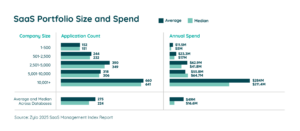
Security remains a top concern for IT leaders. As of 2025, reducing security risks is among the top three business priorities for tech leaders. With a growing number of apps purchased outside IT’s control, many lack the necessary security certifications or never undergo vetting.
A SaaS record of compliance helps highlight which applications have a high-risk score or are missing certifications like SOC 2, ISO 27001, or HIPAA. For example, 60.8% of expensed software in the average portfolio has a poor or low risk score, indicating the need for tighter security oversight.
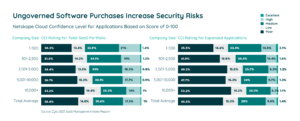
From GDPR to the Digital Markets Act and HIPAA, global and industry-specific regulations are evolving. Today, there are 242 data privacy regulations across 154 countries—with additional regulations sure to come in the future. A record of compliance helps you keep pace by identifying applications that don’t meet certification standards.
Without this visibility, audit readiness becomes a scramble. Worse, you run the risk of noncompliance penalties that can reach millions in fines and damage your brand. This need grows as new frameworks and laws appear regularly, including AI-specific governance measures.
Shadow IT—the use of unapproved software—continues to grow in both volume and cost. In 2024, 45% of applications and 1% of SaaS spend originated from shadow IT.
This situation often results from employees expensing tools to get their job done faster. But while they may be solving one problem, they’re unknowingly creating another. Without the right security and compliance vetting, these apps increase exposure to data breaches and audit gaps.
One of the biggest challenges in SaaS Management is a lack of ownership. When SaaS is shared across departments, no one knows who’s paying for what, or how much is being used. This leads to overbuying and budget surprises.
A SaaS record of compliance assigns software to departments or cost centers. This enables IT, SAM, and finance teams to enforce accountability and drive budget discipline.
License risk comes in many forms. It could be unused licenses that inflate spend, licenses provisioned outside contract terms, or licenses assigned to inactive users or former employees. Each of these poses operational or legal risk.
A record of compliance helps detect and remediate these issues before they become expensive problems—especially ahead of renewals.
Evolving Your SaaS Governance Framework for the Digital Workplace
Visibility alone isn’t enough. You need the right tactics and tools to sustain compliance. Here’s how to make it actionable.
Identifying shadow IT starts with financial discovery. Integrate expense data, AP records, and SSO logs into your SaaS Management Platform (SMP) to find hidden apps. Many organizations are shocked when they uncover tools they didn’t know existed—and the size of the spend tied to them.
From there:
Zylo’s research found that 51% of software is miscategorized in expense reports, underscoring why accurate discovery is critical. You can’t manage what you can’t see.
Not all apps are created equal. Some have strong security protocols, while others have none. A well-maintained record of compliance relies on continuous assessment of each app’s:
When IT has this information, they can proactively remove risk before incidents occur. This is essential for strengthening your organization’s security posture.
All too often, companies renew software blindly. They don’t know how many licenses they’re actually using or whether those licenses align with the right contract terms. This results in wasted spend and unnecessary risk.
Your compliance record should include:
Addressing these not only helps you avoid overpaying—it also protects you in case of audits. Not to mention, prevents unsanctioned user access that could result in data leaks and other security risks.
While SaaS is a shared resource, accountability should be localized. Tagging apps to business units and departments allows you to:
Companies with strong cost allocation are more agile in budgeting and can respond faster to cost-cutting initiatives or strategic shifts.
Zylo stands apart as the industry’s most complete SaaS Management Platform. While many tools offer limited discovery or contract tracking, Zylo brings all SaaS data—inventory, spend, usage, risk, and licensing—into a centralized platform with automation at its core. The result is a dynamic and actionable SaaS record of compliance.
Where other solutions require heavy manual input or deliver static snapshots, Zylo ensures always-on visibility and alerting. That means fewer surprises, faster decision-making, and more strategic value from your SaaS investments.
Zylo’s platform is purpose-built to help IT, SAM, and Procurement leaders create and maintain a complete record of compliance. Here’s how:
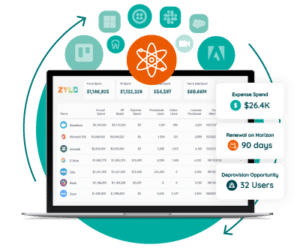 Zylo’s AI-powered SaaS discovery continuously uncovers every application in your environment, whether sourced by IT, purchased by employees, or hidden in expense reports. Unlike basic discovery tools that rely solely on SSO or AP integrations, Zylo combines multiple data sources with the industry’s largest SaaS application library—spanning more than 24,000 known apps—to detect and identify software others miss.
Zylo’s AI-powered SaaS discovery continuously uncovers every application in your environment, whether sourced by IT, purchased by employees, or hidden in expense reports. Unlike basic discovery tools that rely solely on SSO or AP integrations, Zylo combines multiple data sources with the industry’s largest SaaS application library—spanning more than 24,000 known apps—to detect and identify software others miss.
Its AI engine cross-references financial, usage, and login data to recognize patterns, flag anomalies, and accurately categorize spend—even when vendors are mislabeled or masked. This ensures that your inventory stays accurate, current, and audit-ready at all times, giving IT and Procurement a complete and trusted foundation for compliance, cost control, and risk management.
“Visibility into our portfolio was table stakes. We could not begin to manage our software if we could not understand the full scope of it.”
– Vinod Vishwan, Sr. Director at Adobe
Zylo’s Automated Alerts are more than simple notifications—they’re proactive compliance triggers. As your SaaS record of compliance, it continuously monitors new purchases and activities across your environment and alerts relevant stakeholders. That way, action can be taken immediately.
Here are just a few use cases:
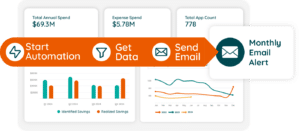
These alerts empower organizations to act before risks escalate, ensuring apps are governed from day one and spend stays within guardrails. That’s the difference between reacting to issues and preventing them altogether.
Zylo’s Security Detail goes far beyond a simple checklist of app certifications. It provides a complete picture of each application’s risk level, helping security, procurement, and compliance teams align quickly.
Key features include:
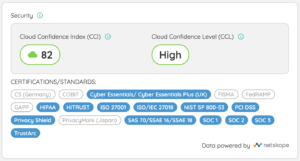
This visibility supports faster incident response, easier audit prep, and informed decisions around app onboarding. Unlike point tools, Zylo embeds this data into your SaaS system of record. Now, risk is no longer an afterthought, but built into every decision. For every app, you can see:
This helps security teams make faster, better-informed decisions.
Zylo enables detailed cost allocation across business units, but its true strength lies in making those allocations actionable and visible. Unlike spreadsheet-based models or retroactive reporting, Zylo dynamically tags apps to departments and cost centers in real time, offering precision and transparency.
Key differentiators include:
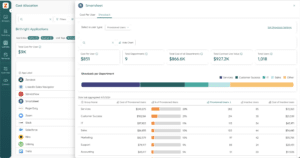
With Zylo, IT no longer needs to chase down budget owners or defend shared expenses. Instead, every stakeholder gains clear insight into what they’re using, what they’re spending, and what it’s worth. This builds a culture of responsibility, making budgeting more predictable and renewals more strategic.
The result: stronger partnerships between IT and finance, fewer end-of-year surprises, and reclaimed budget that can be reinvested in innovation. IT no longer carries the burden for software used elsewhere. With showback and chargeback models, teams become stewards of their software budgets.
This leads to smarter renewal decisions, fewer surprises, and stronger collaboration with finance.
With Zylo, license risk doesn’t sneak up on you—it’s managed proactively with live insights and intelligent workflows. While most tools only track contract dates, Zylo provides a 360-degree view of license health across your entire portfolio.
Here’s how Zylo stands out:
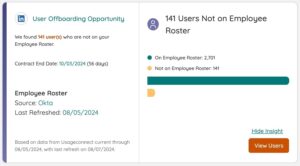
Zylo also supports automated workflows that recommend actions such as reclaiming inactive users or right-sizing license tiers based on usage trends. This turns what was once a spreadsheet exercise into a continuous optimization engine.
The impact? Lower renewal costs, fewer compliance risks, and a streamlined licensing environment that grows with your business. By combining usage data with contract intelligence, it reveals underused or misaligned licenses, helping you take action before renewals.
This reduces spend, ensures legal compliance, and protects against costly audit exposure.
SaaS risk is rising, and most of it is hidden in shadow IT, misused licenses, and unmonitored spend. A SaaS record of compliance gives IT leaders the visibility and control they need.
With Zylo’s SaaS Governance and Risk solution, you can build that record and keep it up to date. Eliminate guesswork, tighten security, and create budget discipline across your software environment.
See why Zylo’s been named a leader in the Gartner® Magic Quadrant™ for SaaS Management Platforms. Request a personalized Zylo demo.

Table of Contents ToggleWhat Is a SaaS Record of Compliance?Defining SaaS...

Table of Contents ToggleWhat Is a SaaS Record of Compliance?Defining SaaS...

Table of Contents ToggleWhat Is a SaaS Record of Compliance?Defining SaaS...

Table of Contents ToggleWhat Is a SaaS Record of Compliance?Defining SaaS...
| Cookie | Duration | Description |
|---|---|---|
| cookielawinfo-checkbox-analytics | 11 months | This cookie is set by GDPR Cookie Consent plugin. The cookie is used to store the user consent for the cookies in the category "Analytics". |
| cookielawinfo-checkbox-functional | 11 months | The cookie is set by GDPR cookie consent to record the user consent for the cookies in the category "Functional". |
| cookielawinfo-checkbox-necessary | 11 months | This cookie is set by GDPR Cookie Consent plugin. The cookies is used to store the user consent for the cookies in the category "Necessary". |
| cookielawinfo-checkbox-others | 11 months | This cookie is set by GDPR Cookie Consent plugin. The cookie is used to store the user consent for the cookies in the category "Other. |
| cookielawinfo-checkbox-performance | 11 months | This cookie is set by GDPR Cookie Consent plugin. The cookie is used to store the user consent for the cookies in the category "Performance". |
| viewed_cookie_policy | 11 months | The cookie is set by the GDPR Cookie Consent plugin and is used to store whether or not user has consented to the use of cookies. It does not store any personal data. |
